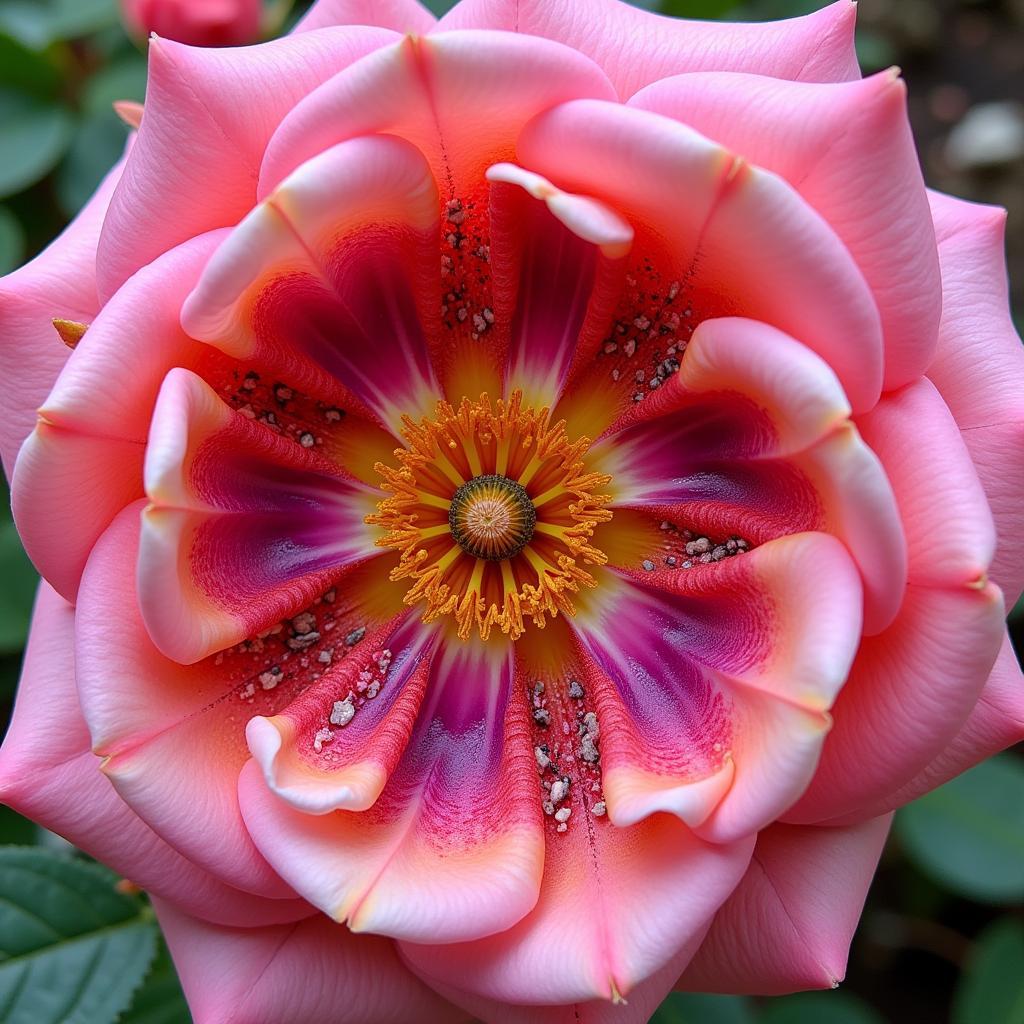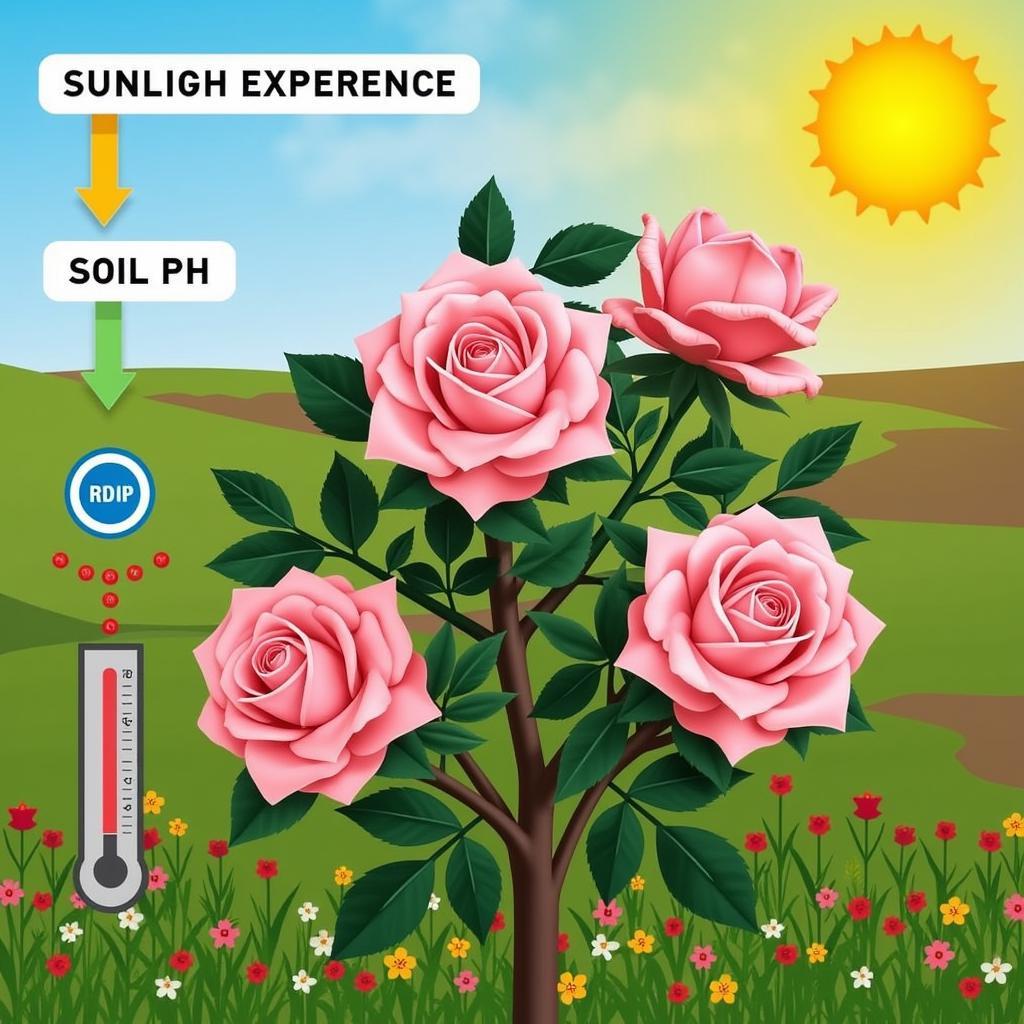Roses, symbols of love and beauty, come in a breathtaking array of colors. Have you ever noticed your roses changing color over time, or wondered, “do roses change color?” The answer is more complex than a simple yes or no, and involves fascinating insights into plant biology, environmental factors, and even clever gardening techniques. Let’s delve into the colorful world of roses and explore the mystery of their ever-changing hues.
Understanding Rose Color: A Symphony of Pigments
Rose color is primarily determined by pigments called anthocyanins and carotenoids. Anthocyanins produce red, pink, purple, and blue hues, while carotenoids are responsible for yellow and orange tones. The specific combination and concentration of these pigments dictate the final color of the rose bloom. You might be interested to know about the range of rose colors available, as described on our page about what colors can roses come in.
The Role of Anthocyanins
Anthocyanins are water-soluble pigments found in the vacuoles of plant cells. Their production is influenced by factors like temperature, light intensity, and soil pH. Cooler temperatures often result in more vibrant colors, while excessive heat can cause colors to fade. Moreover, the acidity or alkalinity of the soil can also affect anthocyanin expression, leading to subtle color variations.
The Influence of Carotenoids
Carotenoids are fat-soluble pigments present in the plastids of plant cells. These pigments are relatively stable and less susceptible to environmental fluctuations compared to anthocyanins. However, factors like light exposure and nutrient availability can still influence their concentration and thus, the intensity of yellow and orange hues in roses.
 Rose Color Pigmentation: Anthocyanins and Carotenoids in Action
Rose Color Pigmentation: Anthocyanins and Carotenoids in Action
Can Roses Change Color? Exploring the Possibilities
So, do roses change color? While a rose bush won’t magically transform from red to blue, subtle color shifts can and do occur. Several factors contribute to these changes, ranging from environmental influences to deliberate human intervention. Want to know more about how to manipulate rose colors yourself? Check out our guide on how to color a rose.
Environmental Factors: The Sun, Soil, and Seasons
Sunlight exposure can cause roses to fade, especially darker hues like red and purple. Soil pH also plays a role, as mentioned earlier, with more alkaline soils sometimes producing bluer hues in certain varieties. Temperature fluctuations, particularly between day and night, can also influence color intensity. Some gardeners even report seeing color variations from year to year, a topic discussed further on our page about whether roses can change color from year to year.
Grafting and Mutations: A Colorful Twist
Grafting, a horticultural technique where two different rose varieties are joined together, can sometimes lead to interesting color variations in the blooms. Mutations, or spontaneous genetic changes, can also occur, resulting in new and unexpected colors.
How to Color a Rose Blue? The Art of Dyeing
While natural color changes are subtle, more dramatic transformations can be achieved through dyeing. This involves adding colorants to the water absorbed by the rose, allowing the petals to take on the desired hue. If you’re curious about achieving specific colors, we have a detailed guide on how to color a rose blue.
 Environmental Factors Impacting Rose Color
Environmental Factors Impacting Rose Color
Expert Insight: Maria Sanchez, Horticulturalist
“Environmental factors play a significant role in rose color. Observe your roses throughout the seasons and you’ll notice subtle shifts in their hues, influenced by temperature, sunlight, and even rainfall.”
Expert Insight: David Lee, Rose Breeder
“Grafting can lead to fascinating color variations, sometimes producing blooms with multiple colors on a single bush. This is a testament to the dynamic nature of rose genetics.”
Conclusion: Embracing the Ever-Changing Beauty of Roses
Do roses change color? The answer is a nuanced yes. While dramatic transformations are typically the result of human intervention, subtle color shifts due to environmental factors are a natural part of a rose’s life cycle. Understanding these factors allows us to appreciate the dynamic beauty of roses and the fascinating interplay of nature and genetics. So, next time you admire a rose, take a moment to appreciate its unique color and the story it tells.
FAQ
- What makes roses change color? Environmental factors like sunlight, temperature, and soil pH, as well as human interventions like dyeing and grafting can cause roses to change color.
- Can I change the color of my roses? Yes, you can change the color of cut roses through dyeing.
- Do all roses change color over time? While all roses are subject to some degree of color variation due to environmental factors, some varieties are more stable than others.
- How can I make my roses more vibrant? Proper care, including adequate sunlight, well-drained soil, and regular fertilization, can help maintain vibrant rose colors.
- Why are my roses fading? Excessive sunlight, extreme temperatures, or disease can cause roses to fade.
- Are blue roses natural? Truly blue roses do not exist naturally. Blue hues are achieved through dyeing or genetic modification.
- Can I predict how my roses will change color? While it’s difficult to predict exact color changes, understanding the influence of environmental factors can give you a general idea.
For further reading, explore the fascinating world of hair color in fantasy literature with our article on what color is feyre’s hair.
Need assistance with choosing the perfect colors for your home? Contact Color Box Hanoi at 0373298888 or [email protected]. Visit our showroom at 86 Cau Giay, Hanoi. Our 24/7 customer service team is ready to help!
